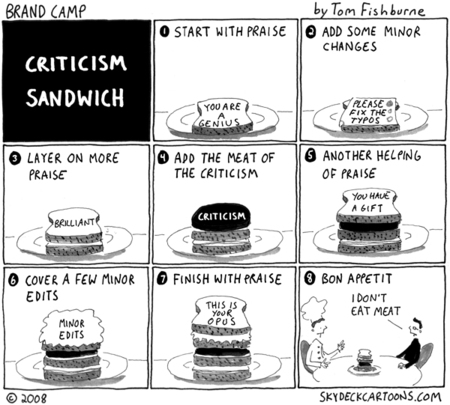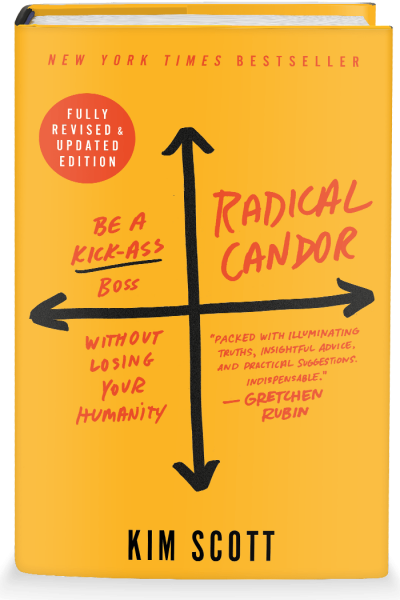Creating a culture based on feedback is incredibly valuable for businesses, but it doesn't happen overnight.
We all know that feedback is essential. Whether you are a manager or working in a team, giving constructive feedback is a core factor to working together effectively, and it's the foundation for building solid relationships. In addition, good feedback helps everyone to grow.
Especially when you are a manager, you want to be mindful of how you provide feedback to your team as it shapes the relationships you build and, therefore, the team's success.
When I first became a manager, I had no training. Does this sound familiar? Unfortunately, this usually happens when you are good at your job, and the business has no programme to support your growth. They promote you to a managerial role without guidance on managing people. However, being a manager is an entirely different type of job than design.
I believe that companies do not often provide training because they underestimate the impact of good managers and the potential of their work to drive business growth. If you simply think that people with great relationships with their managers are happier and more productive, you can understand the importance of having great managers.
You can’t just throw someone into a manager role and expect them to know what to do. Being a manager can be extremely difficult because you are dealing with people, and this goes beyond professional situations, as people have their own lives, personal needs and goals.
In my career, I've been lucky to have had some fantastic managers, and I got to work as a designer on an HR team. As a result, I learned a lot about managing teams, and I had the chance to put it into practice with junior colleagues, even though I didn't manage them directly. However, when I started managing people myself, I found it hard to provide feedback.
I'm ambitious and motivated, but I quickly realised that not everybody likes a manager who focuses only on numbers and achievements. Most of the time, it's about honest relationships. So, I always strive to balance my ambition and help my team succeed. This is simple in theory but much more challenging in practice when managing deadlines, pressure from the business, and life outside of work.
How do you provide good feedback?
The sandwich method is less than ideal

from Tom Fishburne https://marketoonist.com/2008/04/criticism-sandw.html
I thought that providing negative feedback in between two positive acknowledgements was a great practice. It helped me be a more likeable manager, and the person receiving the feedback wasn't upset because of it. With the sandwich method, I could put my points across to help the person to do a better job without upsetting them.
However, the results have been different. I noticed that some of my direct reports were confused about the message of the overall meeting. The whole process didn't show any results, and ending the conversation on such a positive note didn't help reinforce what was necessary to change to reach the set goals.
Honest feedback and the SBIR model
I needed to change my practice, so I looked into different approaches to give my team more effective feedback. My design management course at Coho (formerly OnDeck) was a great way to learn more about feedback, try it out, and ask for help from experienced colleagues.

https://www.radicalcandor.com/
At the same time, Kim Scott's book 'Radical Candor' was an excellent resource for me to learn how to build a team based on feedback and create honest, solid relationships.
Radical Candor—Be A Kick-Ass Leader And Empower Your Team
To begin, I worked on myself to understand the best way to be a manager. I started to be very honest with my team about my personality, ambitions, and work style. I asked for feedback myself regularly to get an outside perspective. I also asked how people wanted to receive feedback and when would be the most suitable time. This gave the conversation context and ensured both parties agreed on the terms.
Then I started applying the SBIR method to conversations with my direct reports, which helped me frame the discussion around specific observations without personal judgement and allowed me to provide actionable recommendations we could both track.
Thaisa Fernandes in her article The Situation-Behavior-Impact-Feedback Framework gets more into the details of the model (without the R), providing excellent tips on preparing for a difficult conversation and how to best follow them up with your direct reports. Let's get into the SBIR details.
S for Situation
Start the conversation by providing the other person with a clear context and establishing a foundation on facts observed in a particular circumstance. By simply describing when and where and asking if the other person remembers the event, you are setting the ground for a more unambiguous conversation.
B for Behaviour
Follow the conversation by describing the behaviour observed. Explain clearly what you have seen or heard, and try to keep the description objective.
I for impact
Describe the impact those actions or words have affected you or others. It is critical to understand the consequences of the action. Before the meeting, I usually ask myself, 'How did it impact others?' or 'What effect did it have on the project?'. It helps me prepare for the meeting and ensure I can show the repercussion of the behaviour on the work.
R for Request
The traditional feedback model doesn't include 'request', or some people refer to this as 'recommendations'. However, you might understand that your behaviour wasn't correct, but you don't know how to fix it or what to do about it. Finishing the conversation by discussing what you would like the person to do differently helps set them on the right path. So, provide clear examples of what behaviour you would like to see and how that would benefit them and the business.
At the end of the day, I see giving feedback as an honest conversation with colleagues to build trust. This is the reason why I seek feedback myself. Having a model to go by is more a way to help me structure my thinking and ensure that I am as clear as I can be.
